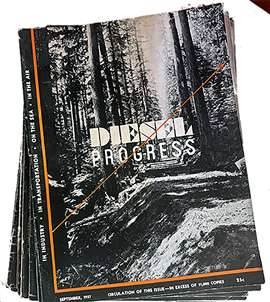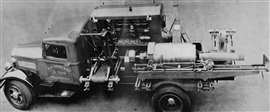Read this article in Français Deutsch Italiano Português Español
Going back 90 years... Diesel Progress September 1937
06 March 2025
W. R. VanSant & Son’s mobile diesel-powered stave mill.
 Every reader likely noticed there was something missing from the cover of the September 1937 issue. There’s no engine nor anything engine-powered, and that was a departure from what had been seen the previous two years. The photo was tied to coverage of logging in the Pacific Northwest, and within the pages there were a half-dozen photos showing massive Caterpillar and Allis-Chalmers crawlers at work in difficult terrain. The concept behind this photo, wrote an editor at the time, was to show an example of the work diesel engines performed. (Photo: Power Progress)
Every reader likely noticed there was something missing from the cover of the September 1937 issue. There’s no engine nor anything engine-powered, and that was a departure from what had been seen the previous two years. The photo was tied to coverage of logging in the Pacific Northwest, and within the pages there were a half-dozen photos showing massive Caterpillar and Allis-Chalmers crawlers at work in difficult terrain. The concept behind this photo, wrote an editor at the time, was to show an example of the work diesel engines performed. (Photo: Power Progress)
Starting with the May 1935 issue, Diesel Progress – or Power Progress as it’s known today – has covered engines and engine-powered equipment. Through those nine decades, the writers and editors of this publication have witnessed the adoption of technology that was considered science fiction in the 1930s and they’ve praised (as proper non-biased journalists) the entrepreneurs, executives and especially the engineers that made that progress possible. It’s been – and it continues to be — an amazing thing to watch. Throughout 2025, we will be celebrating those 90 years. With this department, we’re going back to some of the unique applications, forgotten firms and the companies that have been part of the industry and this media company since the beginning of both.
The mobile diesel stave mill
With the repeal of prohibition, competition among manufacturers of whiskey barrel staves became so strong that W. R. VanSant & Son of Hazard, Ky., were obliged to apply their ingenuity to the problem of cutting manufacturing costs.
They had been using a steam engine to drive their equipment, which was quite satisfactory in so far as fuel was concerned, because they burned sawdust and waste wood. There was, however, this objection: the engine was so bulky that the cost of moving was exorbitant, and moving was necessary.
Moreover, with steam power the plant had to be located near a good water supply regardless of the distance to the timber supply, and oftentimes a satisfactory supply of water was difficult to locate. When a good supply of timber was located quite a distance from the water supply there was, of course, considerable expense involved in hauling bolts to the mill, in addition to hauling staves to the railroad.
Investigation of the possibilities offered by other types of power led to the purchase of a Fairbanks Morse 60 hp diesel engine. This proved so successful that the VanSants decided to carry the program further, and they investigated making their equipment easily portable.
Fairbanks, Morse & Co. and the Schacht truck company [of Cincinnati, Ohio] worked with the owners in designing and building what is believed to be the only outfit of its kind in the country, the “Gypsy Stave Mill.”
 With the repeal of prohibition, competition among manufacturers of whiskey barrel staves became so strong that W. R. VanSant & Son of Hazard, Ky., constructed this mobile stave mill. Diesel Progress (today’s Power Progress) covered the machine in its September 1937 issue. (Photo: Power Progress)
With the repeal of prohibition, competition among manufacturers of whiskey barrel staves became so strong that W. R. VanSant & Son of Hazard, Ky., constructed this mobile stave mill. Diesel Progress (today’s Power Progress) covered the machine in its September 1937 issue. (Photo: Power Progress)
A complete outfit
The complete equipage consists of a Schacht 3-ton special body truck, upon which is installed the diesel connected to a steel line shaft through a Link Belt silent chain. The line shaft is suspended on SKF pillow blocks and ball bearings underneath the machinery supporting channels. The stave mill is driven from the line shaft through another Link Belt silent chain, which is enclosed in an oil-tight housing. Saws and blower are driven from the line shaft through flat belts. The battery used for starting the engine and supplying light is located in the box on the operating side of the engine. A reserve fuel oil tank is located under the battery box.
This outfit is complete in every respect, consisting not only of the truck with all the machinery mounted on it, but camp cars for men and a kitchen car equipped with a coffee roaster in which charcoal sticks for aging whiskey will be made from waste wood.
With this mobile barrel stave manufacturing equipment, the owners now can travel all over the country, working in either small or large tracts of timber, any place near the point an order is to be filled.
Completed staves will be hauled by truck to the customer, cutting down freight charges and long-distance hauling. Moreover, this plant can be operated economically in small tracts of timber where it would not pay to install a stationary outfit.
This department was originally published in the January-February 2025 issue of Power Progress.
POWER SOURCING GUIDE
The trusted reference and buyer’s guide for 83 years
The original “desktop search engine,” guiding nearly 10,000 users in more than 90 countries it is the primary reference for specifications and details on all the components that go into engine systems.
Visit Now
STAY CONNECTED




Receive the information you need when you need it through our world-leading magazines, newsletters and daily briefings.
CONNECT WITH THE TEAM













